
The Hawker Siddeley Nimrod is a retired maritime patrol aircraft developed and operated by the United Kingdom. It was an extensive modification of the de Havilland Comet, the world's first operational jet airliner. It was originally designed by de Havilland's successor firm, Hawker Siddeley; further development and maintenance work was undertaken by Hawker Siddeley's own successor companies, British Aerospace and, later, BAE Systems.
British Aerospace plc (BAe) was a British aircraft, munitions and defence-systems manufacturer that was formed in 1977. Its head office was at Warwick House in the Farnborough Aerospace Centre in Farnborough, Hampshire. It purchased Marconi Electronic Systems, the defence electronics and naval shipbuilding subsidiary of the General Electric Company, in 1999 to form BAE Systems.

The Eurofighter Typhoon is a European multinational twin-engine, canard delta wing, multirole fighter. The Typhoon was designed originally as an air-superiority fighter and is manufactured by a consortium of Airbus, BAE Systems and Leonardo that conducts the majority of the project through a joint holding company, Eurofighter Jagdflugzeug GmbH. The NATO Eurofighter and Tornado Management Agency, representing the UK, Germany, Italy and Spain, manages the project and is the prime customer.
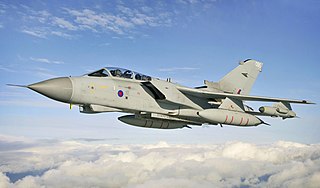
The Panavia Tornado is a family of twin-engine, variable-sweep wing multi-role combat aircraft, jointly developed and manufactured by Italy, the United Kingdom and Germany. There are three primary Tornado variants: the Tornado IDS (interdictor/strike) fighter-bomber, the Tornado ECR SEAD aircraft and the Tornado ADV interceptor aircraft.

The Panavia Tornado Air Defence Variant (ADV) is a long-range, twin-engine swing-wing interceptor aircraft developed by the European Panavia Aircraft GmbH consortium. It was a specialised derivative of the multirole Panavia Tornado.

No. 1435 Flight is a Eurofighter Typhoon FGR.4 unit of the Royal Air Force, based at RAF Mount Pleasant, providing air defence for the Falkland Islands, South Georgia and the South Sandwich Islands. Permanently based in the islands, the aircrew and groundcrew from the UK are cycled through No. 1435 Flight, providing a 365-day, 24-hour alert.

Brimstone is a ground or air-launched ground attack missile developed by MBDA UK for the UK's Royal Air Force. It was originally intended for "fire-and-forget" use against mass formations of enemy armour, using a millimetre wave (mmW) active radar homing seeker to ensure accuracy even against moving targets. Experience in Afghanistan led to the addition of laser guidance in the dual-mode Brimstone missile, allowing a "spotter" to pick out specific and the highest priority targets, particularly useful to minimise collateral damage when friendly forces or civilians were in the area. The tandem shaped-charge warhead is much more effective against modern tanks than older similar weapons such as the AGM-65G Maverick missile. Three Brimstones are carried on a launcher that occupies a single weapon station, allowing a single aircraft to carry many missiles.

Number 3 Squadron, also known as No. 3 (Fighter) Squadron, of the Royal Air Force operates the Eurofighter Typhoon FGR.4 from RAF Coningsby, Lincolnshire, since reforming on 1 April 2006. It was first formed on 13 May 1912 as one of the first squadrons of the Royal Flying Corps – being the first to fly heavier than air aircraft.

The Skyflash, or Sky Flash in marketing material, was a medium-range semi-active radar homing air-to-air missile derived from the US AIM-7 Sparrow missile and carried by Royal Air Force McDonnell Douglas F-4 Phantoms and Tornado F3s, Italian Aeronautica Militare and Royal Saudi Air Force Tornados and Swedish Flygvapnet Saab Viggens.

Number 12 Squadron, also known as No. 12 (Bomber) Squadron and occasionally as No. XII Squadron, is a flying squadron of the Royal Air Force (RAF). The squadron reformed in July 2018 as a joint RAF/Qatar Emiri Air Force squadron. It is currently based at RAF Coningsby, Lincolnshire, and operates the Eurofighter Typhoon FGR4, while temporarily integrating Qatari air and ground crews in order to provide training and support as part of the Qatari purchase of 24 Typhoons from the UK.
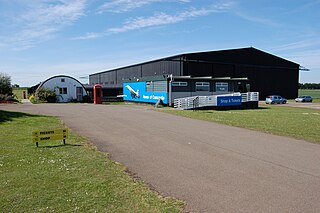
The National Museum of Flight is Scotland's national aviation museum, at East Fortune Airfield, just south of the village of East Fortune, Scotland. It is one of the museums within National Museums Scotland. The museum is housed in the original wartime buildings of RAF East Fortune which is a well preserved World War II airfield. As a result of this the entire site is a scheduled monument with no permanent structures added by the museum. The hangars, control tower and stores were designated as Category B listed buildings by Historic Scotland, but this designation was removed in 2013 as they were already covered by the stricter scheduling.
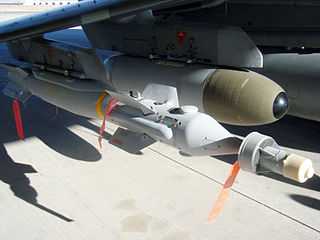
Paveway IV is a dual mode GPS/INS and laser-guided bomb manufactured by Raytheon UK. It is the latest iteration of the Paveway series.
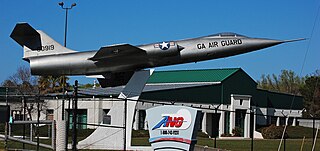
A gate guardian or gate guard is a withdrawn piece of equipment, often an aircraft, armoured vehicle, artillery piece, or locomotive, mounted on a plinth and used as a static display near to and forming a symbolic display of "guarding" the main entrance to a site, especially a military base. Commonly, gate guardians outside airbases are decommissioned examples of aircraft that were once based there, or still are.
The Rainbow Codes were a series of code names used to disguise the nature of various British military research projects. They were mainly used by the Ministry of Supply from the end of the Second World War until 1958, when the ministry was broken up and its functions distributed among the forces. The codes were replaced by an alphanumeric code system.
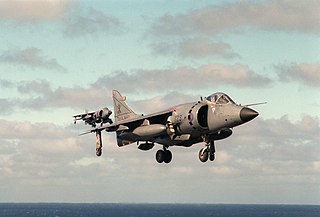
This is a list of the units, aircraft and casualties of the British air services in the Falklands War. The numbers in bold are the number of aircraft used in the war, the numbers in brackets are the number of lost aircraft. For a list of air forces from Argentina, see Argentine air forces in the Falklands War.
BAE Systems Military Air & Information is a business unit of British defence company BAE Systems responsible for the design, development, manufacture and support of fixed wing military aircraft. MAI customers include the Royal Air Force, Royal Saudi Air Force, US Navy and Indian Air Force.

The aerospace industry of the United Kingdom is the second-largest national aerospace industry in the world and the largest in Europe by turnover, with a global market share of 17% in 2019. In 2020, the industry employed 116,000 people.

The MacRobert Baronetcy, of Douneside in the County of Aberdeen, was a title in the Baronetage of the United Kingdom. It was created on 5 April 1922 for Alexander MacRobert, a self-made millionaire. He was succeeded by his eldest son Alasdair in June of that year. Tragedy struck the family again when Alasdair was killed in a flying accident in 1938, and the title passed to his younger brother Roderic. In May 1941 Roderic was killed in action whilst flying a Hawker Hurricane fighter in the Middle East, and just over a month later on 30 June 1941, the title became extinct when the youngest brother Iain, was also killed in action whilst serving with the Royal Air Force. Their mother, Rachel, Lady MacRobert (1884–1954), gave £25,000 to purchase a Short Stirling bomber, the aircraft was named MacRobert's Reply in memory of her three sons. Lady MacRobert believed that her sons had lived up to the family motto Virtutis Gloria Merces – translated as Honour is the Reward of Bravery. The MacRobert Award, which has been presented every year since 1969 by the Royal Academy of Engineering, is named in honour of Lady MacRobert.
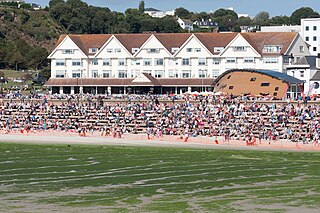
The Jersey International Air Display is an air show which is held every year on the island of Jersey, in the Channel Islands. It normally consists of one air display and two static displays - one at the airport and one in a park in St. Helier.















